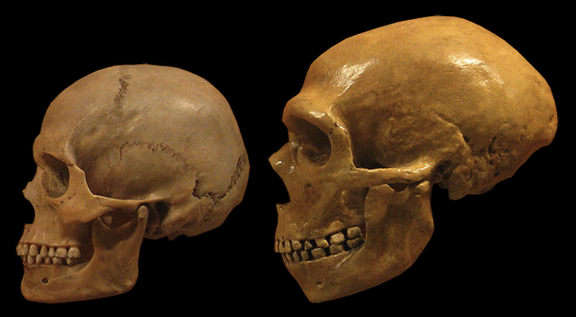Mathematical model indicates Neanderthal disappearance can be explained by genetic dilution

Krystal Kasal
contributing writer

Gaby Clark
scientific editor

Robert Egan
associate editor

Currently, there are several hypotheses surrounding the disappearance of Neanderthals. While they all have at least some scientific support, researchers can't agree on which—or which combination—is most likely. In a new study, in Scientific Reports, researchers use a mathematical model to determine if Neanderthal disappearance could be explained only by genetic dilution from mating with humans through periods of recurrent small-scale immigrations. Their results indicate it certainly was a possibility.
Slow and steady disappearance or catastrophic demise?
Neanderthals originated in Eurasia sometime around 400,000 years ago and were the predominant species of hominins in the region until the arrival of modern humans (Homo sapiens), around 40,000 years ago. Because modern humans came into contact with Neanderthals in waves of immigration events over several thousand years near the time of Neanderthals' disappearance, many researchers think modern humans played a role in their ultimate demise. However, what role they played is unclear.
Four main hypotheses are discussed in the study. One hypothesis blames Neanderthal demographics—small and isolated populations, inbreeding depression, reduced population growth, difficulties finding mates, low birth rates, and high death rates. Another suggests climate fluctuations and disasters were to blame. Another possible explanation is that modern humans brought in new diseases and competition for resources, and the lower populations of Neanderthals could not overcome these new obstacles.
The hypothesis most supported by this new study is a bit less dramatic than the spread of disease or climate catastrophes, which is that the Neanderthal and H. sapien populations simply mixed together over time, resulting in a hybrid (but mostly H. sapien) breed of hominin.
Integration and assimilation
"The present modern human genome reveals multiple instances of genetic introgression with other hominins, with growing evidence that interbreeding led to substantial gene flow between Neanderthals and modern humans. Modern humans still retain a considerable amount of Neanderthal genetic material, at the species level if not in every individual," the study authors explain.
To determine if this admixture alone could account for Neanderthal disappearance, the team developed an analytical model based on neutral species drift and population genetics and simulated repeated immigration cycles of H. sapiens into small Neanderthal tribes. Their model assumes no selective advantage for either species.
Their results indicate that repeated small-scale H. sapien immigrations could almost completely replace Neanderthal genes within 10,000–30,000 years, without the help of any catastrophic events. These results aren't too surprising, as prior archaeological and genetic evidence aligns with this idea.
The authors note that the study isn't necessarily trying to prove that admixture is the only reason that the Neanderthals disappeared, but that it is mathematically feasible.
They write, "Although this model provides a possible robust genetic explanation, it is important to note that it does not
exclude other possible contributing factors that were not considered in our approach, such as environmental changes, competition, or demographic fluctuations.
"Evidence of interbreeding and genetic introgression supports the notion that H. sapiens and Neanderthals interacted extensively over thousands of years. Therefore, the interplay of genetic, demographic, and environmental factors likely contributed to the complex process of Neanderthal demise."
Written for you by our author , edited by , and fact-checked and reviewed by —this article is the result of careful human work. We rely on readers like you to keep independent science journalism alive. If this reporting matters to you, please consider a (especially monthly). You'll get an ad-free account as a thank-you.
More information: Andrea Amadei et al, A simple analytical model for Neanderthal disappearance due to genetic dilution by recurrent small-scale immigrations of modern humans, Scientific Reports (2025).
Journal information: Scientific Reports
© 2025 Science X Network




















